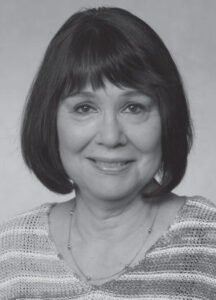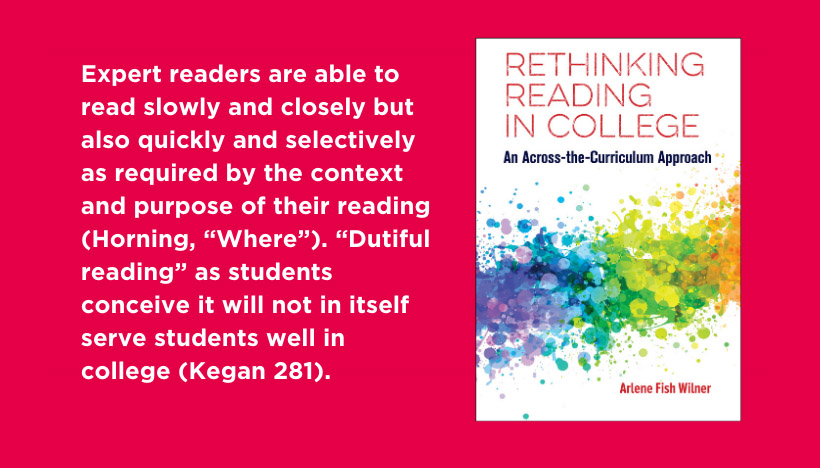This is an excerpt from chapter 3 of Rethinking Reading in College: An Across-the-Curriculum Approach, by Arlene FIsh Wilner (NCTE, 2020).
With so much emphasis on close reading as requisite for comprehension, it is striking to find one of the most compelling proponents of reading across the curriculum (RAC) making the case for a different sort of skill: “Effective reading is fast, not precise and not strictly or even mostly a visual activity” (Horning, “Reading Across”).
This is an important claim that needs both elaboration and qualification. In fact, effective reading is sometimes slow and precise, depending on genre and purpose. Because of their aesthetic qualities and the quality and range of their transactional invitations, literary texts—novels, poems, and short stories, but also rhetorically complex and connotatively rich persuasive or expository texts such as, for example, Jonathan Swift’s notorious “A Modest Proposal,” Martin Luther King Jr.’s “Letter from Birmingham Jail,” the Declaration of Independence, or James Baldwin’s “Stranger in the Village”—do repay close, slow, and careful reading as well as rereading.
Moreover, it is only by the close reading of challenging texts, particularly those that are opaque or call for an aesthetic response, that students can be attuned to the range and complexity of authorial roles and potentials.
In noting the interdependence of sentence rhythms and meaning, Richard Lanham argues persuasively for making deliberate oral reading, currently rather neglected in first-year writing courses, a key practice for novice writers: “Every course in composition ought to be a course in Slow Reading” (146).
However, not all texts require or invite this sort of attention, and some actually discourage it. Lanham observes that the purposefully “neutral” style that is standard in scientific writing “is usually rhythmless, unemphatic, or cacorhythmic” (147). Moreover, as David Jolliffe has noted, the sorts of “strong” reading sometimes taught in first-year composition via texts such as David Bartholomae and Anthony Petrosky’s Ways of Reading—i.e., the practice of approaching the text both as the imagined ideal reader and then as a thoughtful questioner or critic—are not generally expected across the curriculum, especially in general-education courses that tend to rely on informative texts (“Learning to Read as Continuing Education” 476, 479).
And even texts to which we might, under ideal circumstances, devote a lingering engagement must be dealt with more summarily in the interests of practical constraints. Thus successful readers across the curriculum will acquire a repertoire of strategies that can be invoked in the range of textual qualities and occasions for reading.
Expert readers are able to read slowly and closely but also quickly and selectively as required by the context and purpose of their reading (Horning, “Where”). “Dutiful reading” as students conceive it will not in itself serve students well in college (Kegan 281).
Gaining skill in the alternatives—skimming, fast reading, reading to answer a question—is equally demanding and in some ways more so, if those strategies are to be enacted expertly. Even the Common Core State Standards, with their emphasis on close-reading pedagogies, include a brief recognition that practicing close reading alone will not prepare students for the demands of college and the workplace: “Focusing on extended texts will enable students to develop the stamina and persistence they need to read and extract knowledge and insight from larger volumes of material. Not only do students need to be able to read closely, but they also need to be able to read larger volumes of text when necessary for other purposes” (Coleman and Pimentel 4, 15).
The potential drawbacks of a singular focus on slow and meticulous close reading have been illuminated by educational psychologist Robert Kegan’s summary of the process by which students at Harvard in the 1960s and 1970s learned to recalibrate what it means to read (277–81).
Overwhelmed by the amount of reading assigned by their professors and frustrated by their inability to digest it in the ways they thought necessary, the students sought assistance by enrolling in a course designed by William Perry to address this sort of problem. Central to the course design was a series of assignments that redirected students from what they thought of as close and careful reading to first skimming for an answer to a specified question and then, using a different source, gaining a quick overview of the material with the aim of posing their own question.
The first task was enacted repeatedly with various texts, with the goal of decreasing the time required in each case to find the needed answer. As they undertook the second task, students were advised not to read sequentially but to scan as efficiently as possible, perhaps even starting with the conclusion of the text. While neither of these activities—skimming to answer a specific question or speedily gaining a sense of content sufficient to generate a meaningful question—was viewed by the students as “reading,” such approaches were the ones they needed to deal competently with the copious material assigned across their courses.
Some students were even disturbed by what seemed like the dishonesty of such techniques; however, Kegan attributes these feelings to a sense of loss (the deeply embedded sense of what “reading” means, or ought to mean) and to a fear that the self-direction required would put at risk their ability to be in sync with the professor (280).
Overall, the students in this situation who succeeded in dealing with the large amounts of reading in their coursework were enabled to make the transition to a new perspective. What most of them came to learn was that speeding up eye movement alone would not help without a greater sense of confidence in their ability to both answer and ask questions based on their transaction with the text.
According to Kegan, this confidence requires not so much discrete skills as a kind of “courage”—to take charge of the task at hand, to “walk away from being subject to someone else’s questions” (281). That is, the students in this context learned to think of reading as a self-directed activity, one that gave them the ability to construct meaning rather than try only to receive it as passive vessels.
For these students, the assumption that reading is, most centrally, the ability to move one’s eyes from left to right through sequential lines of text had to be replaced by an understanding that making meaning of any text depends on a sense of how parts relate to whole.
 Arlene Fish Wilner, professor of English at Rider University in Lawrenceville, New Jersey, holds a PhD in English literature from Columbia University and was trained in the study of higher education pedagogy as a Fellow of the Carnegie Academy for the Scholarship of Teaching and Learning (CASTL). Inspired by the CASTL experience, she designed and directed BRIDGE (2001–15), a collaborative campuswide faculty development program that facilitated classroom-inquiry projects and supported participants in publishing their research. Her studies in literary theory and interpretation, composition pedagogy, and faculty development have appeared in venues such as Eighteenth-Century Fiction, Children’s Literature, Modern Language Studies, the Journal of Narrative Theory, the CEA Critic, College Literature, Reader, Composition Forum, Pedagogy, Learning Communities Journal, Criticism, and New Directions in Teaching and Learning. Throughout her career, Wilner has been an advocate for more purposeful attention in higher education to the interdependence of reading and writing, with a focus on assignment design.
Arlene Fish Wilner, professor of English at Rider University in Lawrenceville, New Jersey, holds a PhD in English literature from Columbia University and was trained in the study of higher education pedagogy as a Fellow of the Carnegie Academy for the Scholarship of Teaching and Learning (CASTL). Inspired by the CASTL experience, she designed and directed BRIDGE (2001–15), a collaborative campuswide faculty development program that facilitated classroom-inquiry projects and supported participants in publishing their research. Her studies in literary theory and interpretation, composition pedagogy, and faculty development have appeared in venues such as Eighteenth-Century Fiction, Children’s Literature, Modern Language Studies, the Journal of Narrative Theory, the CEA Critic, College Literature, Reader, Composition Forum, Pedagogy, Learning Communities Journal, Criticism, and New Directions in Teaching and Learning. Throughout her career, Wilner has been an advocate for more purposeful attention in higher education to the interdependence of reading and writing, with a focus on assignment design.
Learn more about Rethinking Reading in College: An Across-the-Curriculum Approach (NCTE, 2020).
It is the policy of NCTE in all publications, including the Literacy & NCTE blog, to provide a forum for the open discussion of ideas concerning the content and the teaching of English and the language arts. Publicity accorded to any particular point of view does not imply endorsement by the Executive Committee, the Board of Directors, the staff, or the membership at large, except in announcements of policy, where such endorsement is clearly specified.

